
HO-192

Air pollution can cause significant damage on leaves of field-grown watermelons (Citrullus lanatus [Thunb.] Matsum and Nakai) and muskmelons (Cucumis melo var. reticulatus). The air pollution-induced injury on melons observed in several midwestern and eastern states is principally caused by ozone. Ozone is produced in air during the daylight hours from chemicals released from automobile exhausts and the combustion of fossil fuels (oil and coal) (Figure 1). During the summer months, ozone concentrations in several regions of Indiana have been recorded at levels that could cause injury to crops susceptible to air pollutant injury. Other crops in which ozone injury has been observed in Indiana include potatoes, string beans, tobacco, soybeans, and squash.
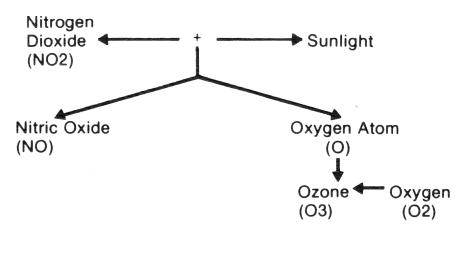
The injury on the watermelon leaves consists of premature chlorosis (yellowing) of the upper surface of the older foliage (Figure 2). The foliage later becomes necrotic (brown or black) (Figure 3), with white spotty patches within the necrotic areas (Figure 4). Ozone injury on muskmelon is similar, except that foliar discoloration on the upper areas goes directly from yellow (Figure 5) to bleached white (Figure 6).
Watermelons appear to be much more susceptible to visible injury caused by air pollution than are muskmelons. Ozone injury on watermelons generally appears in mid to late July prior to fruit maturation.
The injury pattern on the foliage is initially observed on older mature leaves near the crown or center of the plant, often progressing with time to the younger, more vigorous foliage. The yellowing of the plant centers in rows of watermelons is quite distinct and can give fields a visibly striped pattern of alternating yellow and green bands (Figure 7). In other states, this type of injury on watermelon has been descriptively referred to as "center of the crown dieback." In contrast, injury on muskmelons is typically much less severe and is visible at a later stage of plant development. Air pollution-induced injury on watermelons and muskmelons has been experimentally verified in the laboratory.
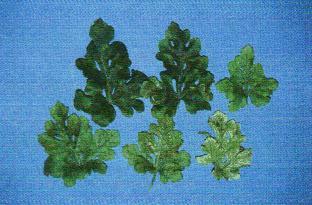
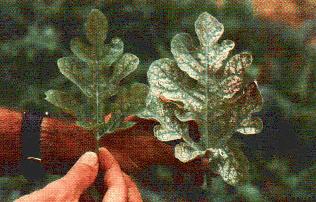
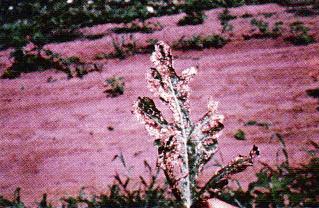

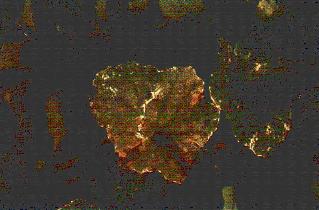
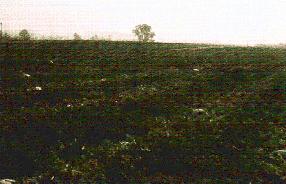
Melon cultivars (cultivated varieties) tolerant and susceptible to injury caused by ambient air pollutants have been identified (Table 1). Tolerant cultivars should be chosen for planting in areas in which air pollution appears to be a problem. However, the selection of a particular cultivar should be based upon many considerations, including its performance (growth, yield, and fruit quality), disease resistance, and marketing opportunities.
Relative Ratings
Tolerant* Intermediate Susceptible
-------------------------------------------------
Watermelon
Charleston Gray Chilean Black Crimson Sweet
Jubilee Mirage Madera
Picnic Tender Sweet Sugar Baby
Supersweet Orange Flesh Moran
Petite Sweet
Blue Belle
Muskmelon
Top Mark Summet Superstar
Hy-mark Laguna Earlisweet
Saticoy Mission Harper Hybrid
Supermarket Goldstar
Classic Hiline
-------------------------------------------------
*Several cultivars are classified as tolerant rather than resistant
because the visible injury that can be observed is at a much reduced
level.
Evaluated at the Southwest Purdue Agricultural Research Center,
Vincennes, IN during the 1984 and 1985 growing season.
Great care is necessary when diagnosing air pollution injury, however, because ozone symptoms closely resemble those induced by nutrient stress and by biotic pathogens (Table 2). Leaf tissues suspected of having injury caused by air pollution should first be analyzed for nutrient content and examined for the presence of pathogenic organisms.
If symptoms are similar to those caused by
OZONE
CHECK FOR:
Mn toxicity (due to low soil pH < 5.5)
N, P, Mg, B, Fe deficiency
Moisture stress
Leaf disease caused by other organisms
Insects (mites, thrips)
Pesticide Toxicity
Virus Infection
It symptoms are similar to those caused by SULFUR DIOXIDE
CHECK FOR:
N, K, Mn, Mg, Ca deficiency
Moisture stress
High temperature
Pesticide toxicity
Leaf diseases caused by other organisms
Modified from Lacasse, N.L. and M. Treshow (ed). 1976.
Diagnosing Vegetation Injury Caused by Air Pollution.
Air Pollution Training Institute Applied Sci. Assoc. Inc.
To obtain copies of the Station Bulletins cited here, contact: Extension Office, Department of Horticulture, Purdue University, West Lafayette, IN 47907.
Experiment Station Bulletin No. 423, Purdue University.
Smith, M. and D. Brown. 1982. Crop benefits from ozone reduction: An economic analysis. Agricultural Experiment Station Bulletin No. 388, Purdue University.
New 1/86
Cooperative Extension work in Agriculture and Home Economics, State of Indiana, Purdue University and U.S. Department of Agriculture cooperating: H.A. Wadsworth, Director, West Lafayette, IN. Issued in furtherance of the acts of May 8 and June 30, 1914. The Cooperative Extension Service of Purdue University is an equal opportunity/equal access institution.